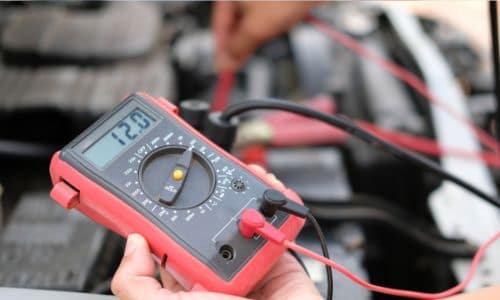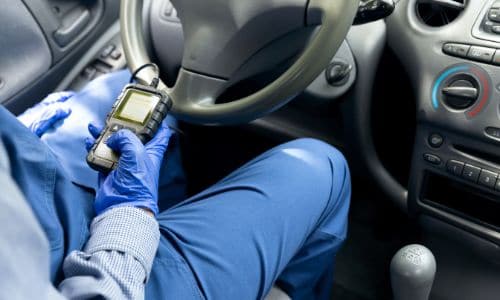Your car’s battery is its unsung hero. It’s probably the only component that keeps things alive 24 hours a day, and you’d probably never even notice its presence until it gives up the ghost. That’s why it is important to periodically check your car battery’s health, test it, and ensure timely replacement to avoid being stranded. The voltage of a car battery is one indicator of its health, and in this article, we will explain all about it. You might also want to check out our article on how to test a car battery.
How many volts is a car battery? The label may say 12 volts but that’s not the full story. We will explain what voltage is, why a car battery has to maintain a certain range of voltage under varying conditions, how to test your car battery, how diagnostic solutions such as Carly can help you here, and other things that can be done with such diagnostic solutions.
GAIN MORE CONTROL OF YOUR CAR WITH THE CARLY FEATURES
Check the exact pricing of Carly for your car brand!

Fast International Shipping with DHL

14 days adaptor return policy

Excellent customer support

Lifetime warranty in the hardware
SEEN IN







Why Does My Car Need a Battery?

Even when your modern car is switched off, it is not truly off. There are several computer control units that are in a state of slumber, rather than being fully switched off. It is the duty of your car battery to provide them with the power required to stay asleep, ready to wake up at a moment’s notice as you crank the key or press the starter button to fire up the engine.
Furthermore, there are certain systems in a car that must function even if the car is switched off. These include the head and tail lamps, indicator lamps for hazard light functionality, horn, and brake lamps upon pressing the brake pedal. The car battery provides power for all these to operate, which is why knowing how many volts is a car battery is important.
Let’s not forget the moment when the car battery must summon up all its reserves in a Herculean effort, and that’s when you turn the key or press the starter button to fire up the engine. The starter motor pulls a significant amount of power from the car battery which it needs to get your engine and its pistons turning, so that internal combustion may occur. This is why we call the car battery the unsung hero; it performs several critical roles without you ever knowing it.
How Many Volts Is a Car Battery: What Is Voltage?
If you want to know how many volts in a car battery exist, then there’s a simple way to define it: voltage is the pressure from an electrical circuit’s power source — in this case, the car battery — that pushes charged electrons through a conducting loop, enabling them to do work. Voltage is also known as the difference in electric potential between two points. Current on the other hand, is the rate of flow of electrons. Voltage and current are intrinsically linked. Vehicles with larger displacement engines and more complex electrical systems require batteries with higher current ratings.
How Many Volts Is a Car Battery?
A typical modern car battery is rated at 12 volts (v). It became this way because, in early times, six volts was the usual amount of power that reasonably sized batteries at the time could produce, and components were designed for this. As electrical demands grew, component voltage ratings were doubled, since two six volt batteries could be coupled to provide the increased power requirement. Over time, this morphed into a single 12v battery and has remained so to this day.
There are other voltage standards in cars, such as the drive batteries in hybrid and electrical vehicles that can be hundreds of volts, as well as the 48v systems in certain cars that power mild hybrid systems. However, we will focus on the 12v battery in this article.
How Can I Check My Car Battery’s Voltage?

One easy way is to borrow a multimeter, or better, purchase one. You can find them cheaply, at $20 onwards for a decent one and it’s an invaluable piece of kit to have in your home and car toolkit. Locate the battery in your car, common locations include under the hood, beneath the passenger seat, or in the trunk. Switch on the multimeter and set it to measure DC voltages, with the maximum range set to at least 20v, or 50v. Ensure your car is fully switched off at this stage.
Touch the multimeter’s red probe to the positive terminal of the battery, marked with a +, and the black probe to the negative terminal, marked with a -. Ensure that you do not touch any other part of your car with the probes. If your multimeter indicates a reading of around 12.2 volts or more with a fully switched off car. If the value is at 12.0 volts or lower, the battery is bad and needs to be replaced. However, if your car has been parked for several weeks without being run, it’s a good idea to first run your car for a few minutes, shut it off, and take a reading.
Now, turn on your car and take another reading. The voltage across the terminals should read between 14 and 14.5 volts. If this is the case, it signifies that your car’s battery charging system is working as intended. If the indications are lower, it could either be a bad battery, or a faulty charging system.
However, this is a very rough testing method. For a more comprehensive method, a diagnostic scanning solution is your best bet, and for that, we recommend Carly as your trusted automotive diagnostic and maintenance partner.
What Is Carly?
Carly is a trusted and proven integrated solution that includes all hardware and software required to do a diagnostic scan using nothing more than your smartphone. The hardware component of Carly consists of the Carly Universal OBD Scanner, a small dongle that plugs into your car’s OBD2 port and wirelessly communicates with your smartphone. Install the Carly app on your smartphone via the official Android or Apple app stores, and you’re ready to go.
Carly costs under $100 for the hardware and software components, representing outstanding value for a long-term diagnostic and maintenance solution that you can take anywhere with you. If you’re concerned about reliability and longevity, Carly’s components have been engineered to work with each other, have undergone ample testing, and regular updates are released. You can even install the Carly lite app to check out what Carly can offer for you car before making a purchase.
How Can Carly Help?

Carly’s comprehensive suite of diagnostic scanning solutions for your car include testing its battery and charging system and will alert you of any critical faults, such as a bad battery or weak charging system. Certain makes and models allow you to initialize the battery in Carly, enabling in-depth diagnostics on battery health that go beyond what traditional diagnostic solutions can achieve.
Of course, Carly’s diagnostics go beyond battery and charging systems in your car, and in fact, can scan every single computer control system for faults. This makes Carly exceptional as a preventative detection and maintenance tool, as you can perform a scan whenever you wish, instead of needing to visit and pay for a workshop for it. The recommended interval to scan a car with average mileage is once every three months, and for older cars or heavy milers, once a month is not uncommon. With scans costing between $30 and $80 at a workshop, you can quickly recover the purchase price of Carly.
What Else Can Carly Do?
Carly can allow you to customize various aspects of your car via the coding function, reset maintenance counters after performing tasks such as oil and filter changes, and even detect mileage tampering in used cars via the Carly Used Car Check. Why not give Carly a try and see what it can do for you?

